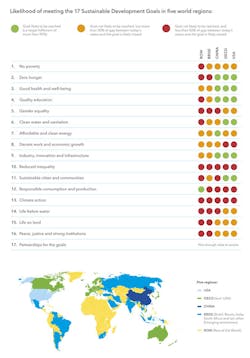Will the world achieve the United Nations’ (U.N.'s) 17 sustainable-development goals (SDGs) by 2030? What can business do to lead the charge? DNV GL, provider of classification, technical-assurance, software, independent expert advisory, and certification services, set out to answer these questions in its new forecast examining the future of our “Spaceship Earth.”
The report concludes that, while progress toward many of the goals will be made across several world regions, action will not be fast enough or fair enough and will come at an unacceptable environmental cost. However, there still is time to reset our course: The report highlights 17 global companies, including Grundfos and Siemens, driving extraordinary progress toward each of the global goals.
“For the most part, business has the technology, people, and processes to rock the world," DNV GL Group President and Chief Executive Officer Remi Eriksen said. “The challenge, therefore, isn’t the ‘smarts’; it’s the take-up of the solutions proposed and piloted—the real scaling of these interventions.”
All of the companies featured in the report are signatories to the U.N. Global Compact, an initiative to encourage businesses worldwide to adopt sustainable and socially responsible policies.
Key findings from the "Future of Spaceship Earth" report include:
- None of the global goals will be met in all regions of the world. Moreover, not even half of the goals will be met in any of the regions.
- The energy transition is not fast enough. The replacement of fossil fuels with renewable-energy sources is under way. On the current trajectory, we will exceed the carbon budget by 2037, entering increasingly dangerous climate-change territory.
- Energy demand will level off. From 2030 onward, growth in energy demand will level off because improvements in energy efficiency will outpace the energy demands created by growth in population and productivity. Additionally, increases in urbanization and education will result in lower fertility rates, reducing energy demand, and lower productivity growth in more mature service economies will stabilize energy demand.
For more information and to download the report, click here.










